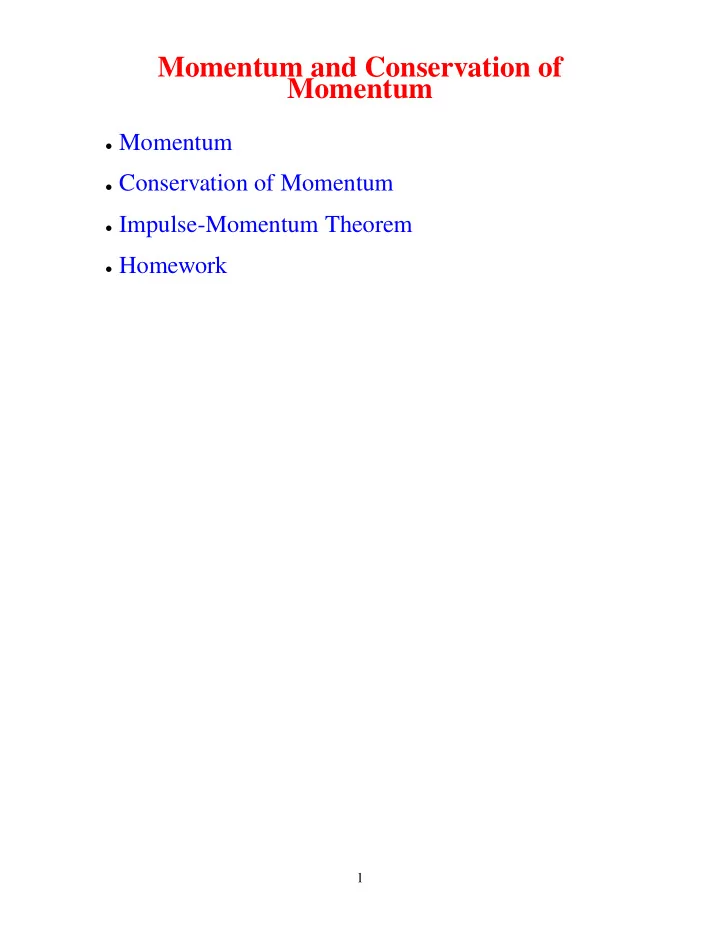

Momentum and Conservation of Momentum • Momentum • Conservation of Momentum • Impulse-Momentum Theorem • Homework 1
Momentum • The linear momentum, p , of a particle with mass, m , moving with a velocity, v , is defined as p = m v • In general, the momentum, p , has three components p x = mv x p y = mv y p z = mv z • Alternative statement of Newton’s 2 nd law: The time rate of change of momentum of a particle is equal to the net force acting on the particle. Σ F = d p dt • If the mass of the particle is constant, we get our pre- vious expression for Newton’s 2 nd law Σ F = d p dt = d ( m v ) = md v dt = m a dt 2
Conservation of Momentum • The total momentum for a system of particles is p tot = Σ p i = Σ m i v i • Applying Newton’s 2 nd law, we have Σ F ext = d p tot dt • If Σ F ext = 0 , then d p tot dt = 0 so that p tot = constant 3
Example 1 A bullet with a mass of 3.8 g is fired horizontally with a speed of 1100 m/s into a large block of wood with a mass of 12 kg resting on a frictionless surface. What is the speed of the block after impact? 4
Example 1 Solution A bullet with a mass of 3.8 g is fired horizontally with a speed of 1100 m/s into a large block of wood with a mass of 12 kg resting on a frictionless surface. What is the speed of the block after impact? m v i v f M M+m Initial Final p i = p f mv i i = ( M + m ) v f i m v f = M + mv i 3 . 8 × 10 − 3 kg v f = 12 kg + 3 . 8 × 10 − 3 kg (1100 m/s ) = 0 . 35 m / s 5
Impulse-Momentum Theorem • Assume that a net force Σ F acts on a particle and that it may vary with time as shown below • We can use Newton’s 2 nd law to write the differential change in momentum, d p , in the differential element of time, dt , as d p = Σ F dt 6
Impulse-Momentum Theorem (cont’d) We can integrate this expression to find the change in momentum, ∆ p , of the particle during the time interval ∆ t = t f − t i � p f � t f p i d p = t i Σ F dt � t f ∆ p = p f − p i = t i Σ F dt The integral of force over the time interval during which it acts is a vector quantity called the impulse, I , defined by � t f t i Σ F dt = ∆ p I ≡ We can also express the impulse in terms of a time-averaged net force Σ F I = ∆ p = Σ F ∆ t 7
Example 2 A 0.14-kg baseball, in horizontal flight with a speed v i of 39 m/s, is struck by a batter. After leaving the bat, the ball travels in the opposite direction with a speed v f , also 39 m/s. (a) What impulse acted on the ball while it was in contact with the bat? (b) What average force acts on the baseball if the impact time is 1.2 ms? 8
Example 2 Solution A 0.14-kg baseball, in horizontal flight with a speed v i of 39 m/s, is struck by a batter. After leaving the bat, the ball travels in the opposite direction with a speed v f , also 39 m/s. (a) What impulse acted on the ball while it was in contact with the bat? (b) What average force acts on the baseball if the impact time is 1.2 ms? ( a ) I = p f − p i = mv f i − ( − mv f i ) = m ( v f + v i ) i I = (0 . 14 kg )(39 m/s + 39 m/s ) i = 11 kg · m/s i ∆ t = 11 kg · m/s i F = I ( b ) = 9200 N i 0 . 0012 s 9
Homework Set 14 - Due Wed. Oct. 13 • Read Sections 8.1-8.2 • Answer Questions 8.3 & 8.9 • Do Problems 8.1, 8.4, 8.7 & 8.10 10
Recommend
More recommend